Samsung Galaxy S21 Ultra vs iPhone 12 Pro Max
We may earn a commission if you make a purchase from the links on this page.

The Galaxy S21 Ultra and the iPhone 12 Pro Max are the two best and most feature-packed phones that Samsung and Apple make. These are the phones where the two companies have pulled all the stops: they have the best and brightest screens available, the most advanced camera systems, fastest processors, and biggest batteries.
As a short summary, between them, the Galaxy is the one that has the more versatile camera system with two zoom lenses at 3X zoom and 10X zoom, compared to a single 2.5X zoom camera on the iPhone, so you get much cleaner zoom photos and videos on it. The Galaxy also has a 120Hz fast refresh rate screen for smoother scrolling that the iPhone lacks. Plus, it also runs on Android, which is the more open ecosystem that allows you to customize your phone anyway you like, and you have a fingerprint scanner instead of face recognition, which comes in handy for these mask wearing times.
The iPhone while lacking a bit in cool features and camera zoom tricks, runs the very dependable and familiar iOS, and has the faster processor that beats the Galaxy in benchmarks and is more future-proof. The iOS software also feels a bit more refined and prettier, Apple’s emoji look a lot better, you have iMessage, and Apple will deliver software updates for about 5 years, while the Galaxy only gets 3 years of software updates, and they will arrive with a bigger delay.
Of course, you also need an iPhone if you want to use the popular Apple Watch, and the iPhone fits in nicely in the Apple ecosystem with features like AirDrop for fast wireless sharing, AirPlay for smart speakers, and then gadgets like AirPods and AirTags, and so many other cool accessories.
But that's just touching the surface, let's dive in and explore the differences in detail, so you can make the best choice between these two.
You might also like:
Display
With a fast, 120Hz refresh rate the Galaxy has the smoother moves
Both the Galaxy S21 Ultra and iPhone 12 Pro Max have extra large screens that produce beautiful colors without much of a drop in quality when you view the screen at an angle, plus both of them get much brighter than your average phone so you can comfortably use them outdoors.
On paper, it is the Galaxy that has the slightly bigger screen. The difference of 0.1 inches, however, is barely noticeable, and these two are clearly stretching the limits of how big a screen you can get in a non-foldable phone.
For the screen nerds, here are the display specs for each of the phones:
| Galaxy S21 Ultra | iPhone 12 Pro Max | |
|---|---|---|
| Display size | 6.8", curved | 6.7", flat |
| Technology | OLED | OLED |
| Resolution, density | 1440 x 3200 pixels, 516ppi | 1284 x 2778 pixels, 458ppi |
| Frame rate | 10Hz - 120Hz Dynamic | 60Hz |
| Peak brightness | 1,500 nits | 1,200 nits |
| Additional features | HDR support | HDR support |
One signature iPhone screen element remains the notch, which houses its complex Face ID sensors and front camera, while the Galaxy S21 features a much more discrete punch hole front camera that doesn't obstruct your view. It's easy to get used to the iPhone notch in everyday, casual use, but it can be very noticeable when you watch videos and particularly when you play games.
The Galaxy has a different peculiarity: a slightly tapered screen compared to the flat one on the iPhone. The tapered screen makes for easier swiping motion and it also helps achieve a thinner bezel-look for a more futuristic, all-screen appearance.
The Samsung has a couple of other advantages too: its screen has a slightly higher resolution which results in sharper detail. Don't expect the iPhone to look pixelized in any way, instead expect to see a slight difference in favor of the Galaxy if you really look up close. Most importantly, the screen on the Galaxy can run at a 120Hz refresh rate, twice as fast as the 60Hz on the iPhone, and this makes scrolling zippier and smoother than on the iPhone. New on the Galaxy is that this fast refresh rate can be used at the full resolution, plus the screen will automatically adjust the refresh rate, so the max 120Hz speed will be used only when needed, while the rest of the time the screen can smartly switch to a lower and more power-efficient refresh rate (as low as 10Hz).
The Samsung has a couple of other advantages too: its screen has a slightly higher resolution which results in sharper detail. Don't expect the iPhone to look pixelized in any way, instead expect to see a slight difference in favor of the Galaxy if you really look up close. Most importantly, the screen on the Galaxy can run at a 120Hz refresh rate, twice as fast as the 60Hz on the iPhone, and this makes scrolling zippier and smoother than on the iPhone. New on the Galaxy is that this fast refresh rate can be used at the full resolution, plus the screen will automatically adjust the refresh rate, so the max 120Hz speed will be used only when needed, while the rest of the time the screen can smartly switch to a lower and more power-efficient refresh rate (as low as 10Hz).
And here are our display measurements for each of these screens:
The only slight privilege the iPhone offers is the smoother touch responsiveness of iOS that doesn't "jump" the screen a tad when you put on or lift off your finger.
In all of the important display quality aspects, however, Samsung has the lead and if you are really picky about your screen, the Galaxy is the better one.
Plus, the S21 Ultra adds a digitizer for S Pen support, a neat extra.
Performance
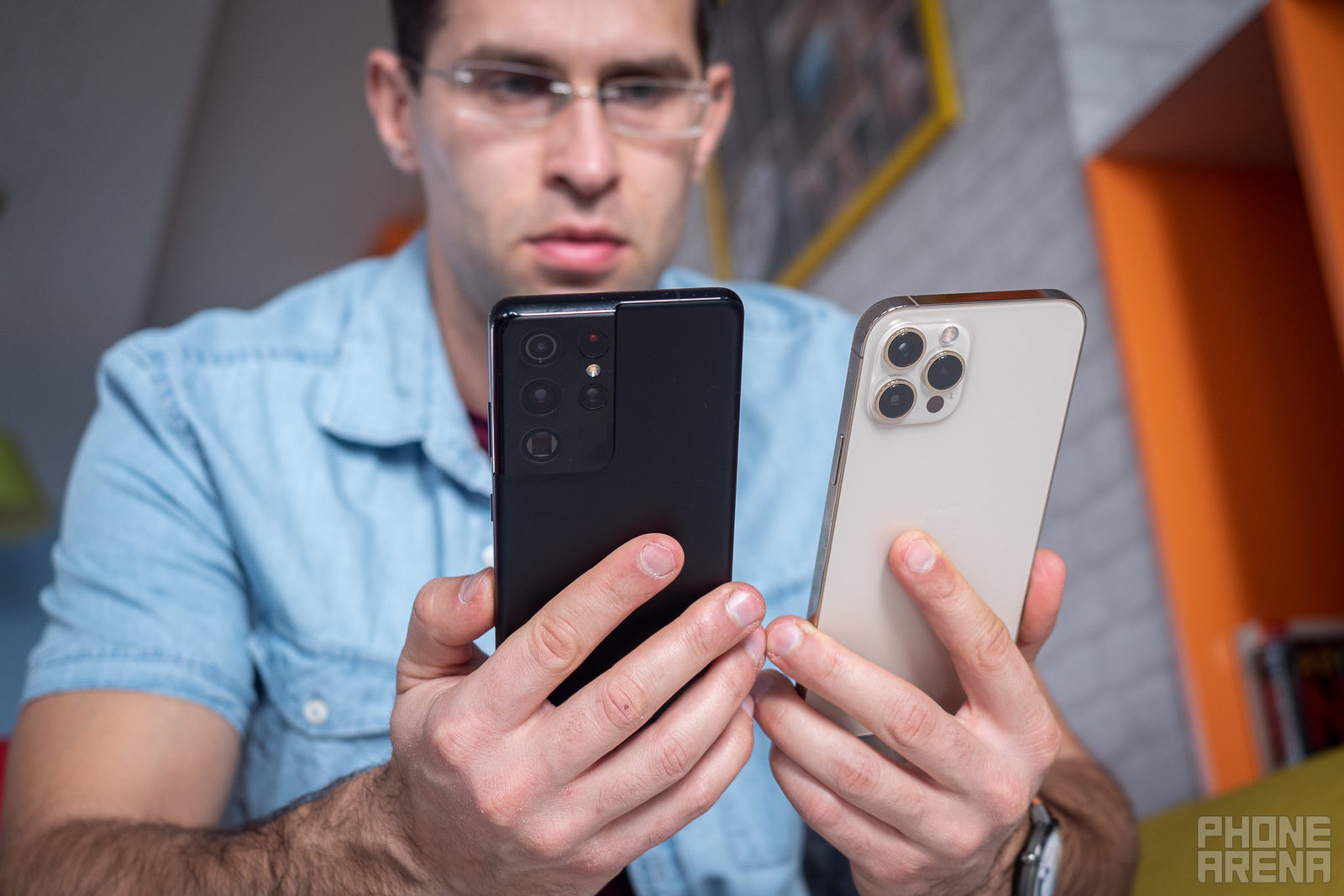
The Galaxy S21 Ultra comes equipped with the latest and most powerful Qualcomm Snapdragon 888 chip in the United States, while international models will ship with a Samsung-made Exynos 2100 processor, which this year is expected to finally match the Snapdragon in both performance and power efficiency. On the other hand, the iPhone 12 Pro Max uses the Apple A14 Bionic chip.
Both manufacturers use the most advanced technology available for these processors: 5nm manufacturing, so no difference on that end. Still, Apple's A14 chip has a notable advantage in both single-core and multi-core performance.
Interestingly, the graphics performance on both chips is quite similar. In the GFXBench Car Chase on-screen test that we performed at 1080p resolution, both scored nearly the same.
In terms of storage, the base Galaxy S21 Ultra model starts at 128GB of on-board memory, matching the storage offered on the iPhone 12 Pro Max. The Galaxy S21 is also skipping the microSD card slot for the first time on a Galaxy flagship, so now it is just like the iPhone, with NO way to expand the storage... unless you buy a pricier version with more storage from the get-to.
Of course, both phones are available on all major carriers across the globe and in the United States, and they support 5G connectivity with all bands required. In the US, both support the sub-6GHz and mmWave types of 5G.
Of course, both phones are available on all major carriers across the globe and in the United States, and they support 5G connectivity with all bands required. In the US, both support the sub-6GHz and mmWave types of 5G.
Sustained Performance in gaming
This test will be of particular interest to gamers. While most benchmark only run for a couple of minutes, the 3D Mark Wildlife benchmark loops for 20 minutes, which allows users to to see whether the chips inside the phones will throttle after a while, a behavior that you don't catch with other benchmarks. Indeed, we see that the Exynos 2100 chip inside the S21 Ultra throttles in a big way around the 15th minute of the test, losing around 30% of its initial performance. Not only that, the temperature grows to a quite hot 42° C.
At the same time, the iPhone 12 Pro Max has a huge burst in performance in the very first test run, and then quickly scales back by around 25%, around the 3rd minute of the test, and from there on it runs at that steady pace.
And just looking at the frame rate of the benchmark towards the end of the test, the iPhone runs at a steady 30+ fps, while the Galaxy averages a bit over 20fps, so that is a significant difference in favor of the iPhone.
Camera
Two telephoto zoom cameras on the Galaxy might make it the most versatile zoom camera, but only the iPhone has a LiDAR sensor for AR
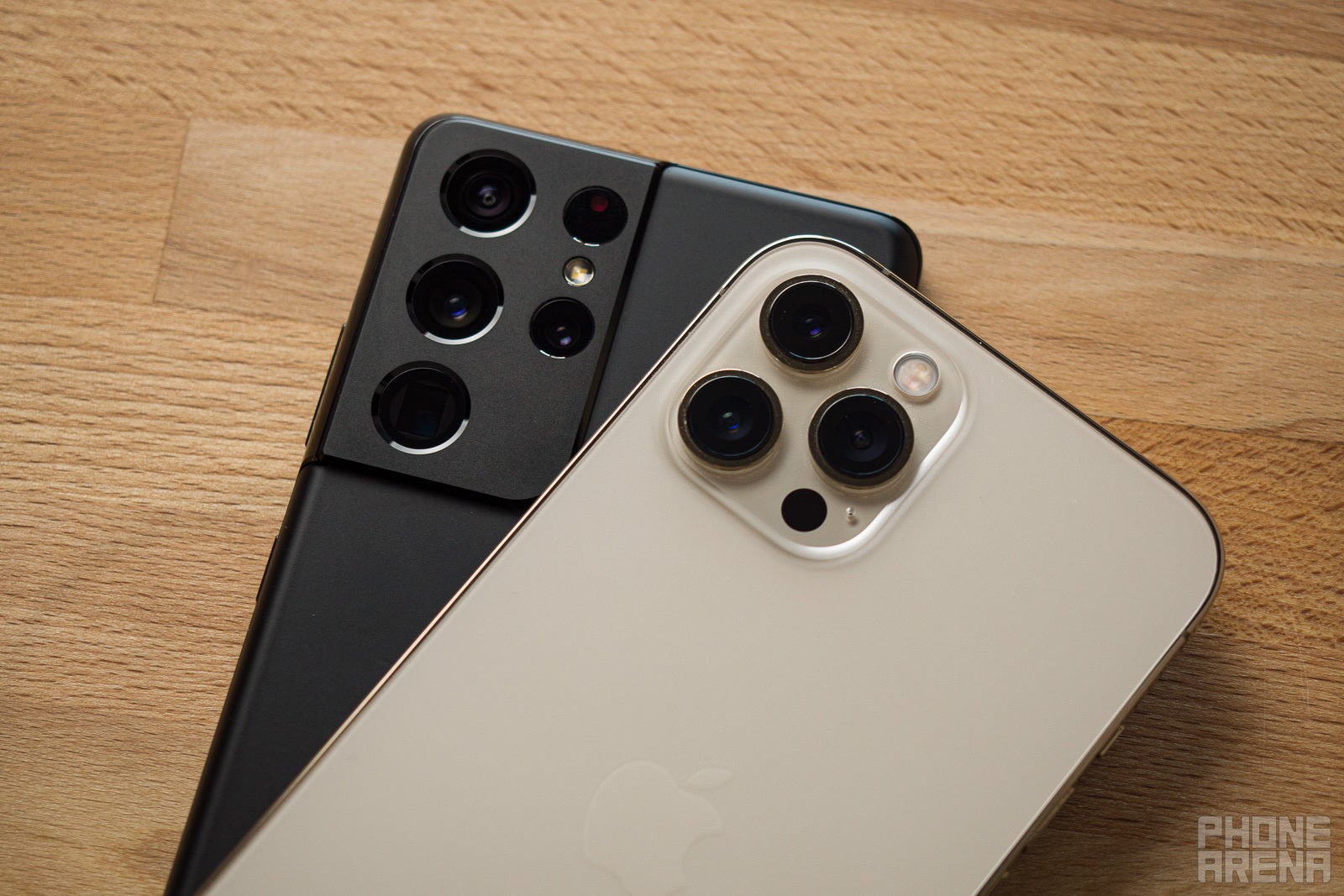
The Galaxy S21 Ultra brings a new style to the camera unit which now blends with the side of the phone, while the iPhone features that recognizable stove top like design for the cameras. Both are very distinct and easily recognizable, but also both feature raised camera beds, so both phones will wobble if you lay them back down on a table without a case.
Apart from the styling differences, there are some big differences in the amount and specs of the cameras.
The Galaxy has the upper hand with two telephoto cameras, while the iPhone only has one zoom camera.
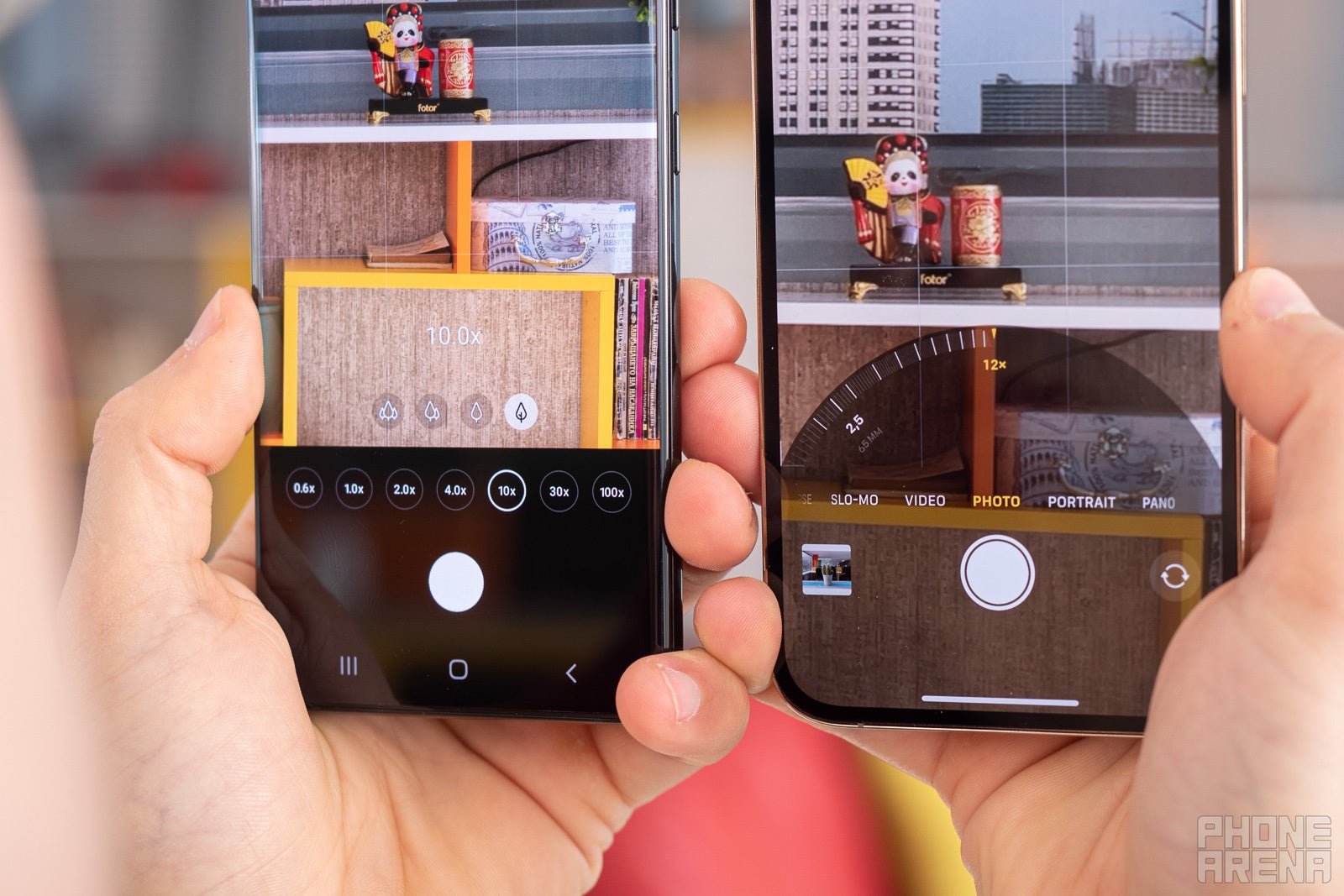
On the Galaxy, you get a periscope lens, with a long-range, 10X zoom capability, and then, you also have a secondary zoom camera, this one being a short-range 3X zoom lens. Combined together, these two cameras make the Galaxy clearly the superior phone for when you have to get a clear picture of something far away.
Here are the detailed camera specs:
| Galaxy S21 Ultra | iPhone 12 Pro Max | |
|---|---|---|
| Main Camera | 108MP, 24mm f/1.8 lens with OIS | 12MP, 26mm f/1.7 camera with sensor shift stabilization |
| Secondary Camera | 12MP ultra-wide, 13mm | 12MP ultra-wide, 13mm |
| Third Camera | 10MP, 3X zoom telephoto lens (72mm, f/2.4) with OIS | 12MP, 2.5X zoom telephoto lens (65mm) with OIS |
| Fourth Camera | 10MP, 10X zoom periscope lens (240mm, f/4.9) with OIS | - |
| Additional sensors | Laser auto focus | LiDAR sensor |
Notice that the Galaxy has a wider main camera. It uses a 24mm lens versus a 26mm lens on the iPhone (and most other phones for that matter). This might not sound like a huge difference, but it will result in a wider perspective.
*Notice the iPhone has cleaner detail around the helm of the boat, but the Galaxy has a wider field of view
The most impressive feature of the Galaxy has got to be its zooming ability, so let's see how it compares against the iPhone:
That really is one world of a difference, the Galaxy truly impresses here. Next up, let's take a look at a real challenge, low-light photos! Keep in mind that the photos below were captured using auto mode with Scene Optimizer enabled on the Galaxy and we have also used the Auto mode on the iPhone.
Video Recording
On the video side, the S21 Ultra can record 8K video at 24fps, while the iPhone 12 Pro Max does not support such a high resolution and maxes out at 4K. 8K video does come with a few limitations, most importantly, it lacks proper video stabilization and the nearly twice as large file sizes mean that it's not an option you should use on a daily basis. However, for those special, cinematic moments that you want to make last, it's a welcome feature.
Both the Galaxy and the iPhone can also record HDR videos at 4K for richer colors. HDR stands for high dynamic range and in video, it actually makes brighter parts of the video appear... even brighter, and since it captures a lot more color, you get smoother gradients that look better. Actually, Galaxy phones have been able to record HDR video since the Galaxy S10, and they have built on top of the open HDR10 standard (Samsung calls it HDR10+). The latest iPhones, however, shoot HDR videos by default, and that's an important difference. Apple uses the proprietary Dolby Vision HDR standard, but at the end of the day, good news is that you can easily export an HDR video from both the Galaxy and the iPhone to say, YouTube, and you can enjoy the benefits of HDR on both phones.
If you record the non-HDR version of 4K, we noticed the iPhone does a bit better with cleaner detail and also, in extreme low light the Galaxy fails to squeeze out enough light and videos on it appear way too dark. However, it would be short sighted to just give the iPhone the win because it is just not a match for the Galaxy in terms of zooming! The Galaxy can go all the way to 20X zoom in video, but what's more important is that the quality is just incredible and the footage looks surprisingly stable and free of jitter. As for the iPhone... well, let's just say you don't really want to zoom that far on the iPhone.

Loudspeaker and Sound Quality
Loudspeakers on phones are usually not the biggest focus, but if you are too lazy to reach out for headphones and just want great sound from the speakers, it obviously matters quite a lot.
The Galaxy S21 Ultra, however, disappointed us with its loudspeaker quality. Both the Galaxy and the iPhone use a combination of a down-firing "main" speaker that works in concert with a "helper" speaker built inside the earpiece. The Galaxy sound, however, lacks in the lower tonalities, the bass part of songs sounds flat, while the highs can be a bit too piercing and the overall sound profile is just not what you would expect from a flagship phone. The iPhone is not the phone with the very best speakers out there (that honor goes to the Asus ROG Phone 5, which is just incredibly good), but it is far better with much more depth and a fuller sound profile, so if loudspeaker quality matters to you, the iPhone is the one you should go for.
Battery Life and Charging speeds
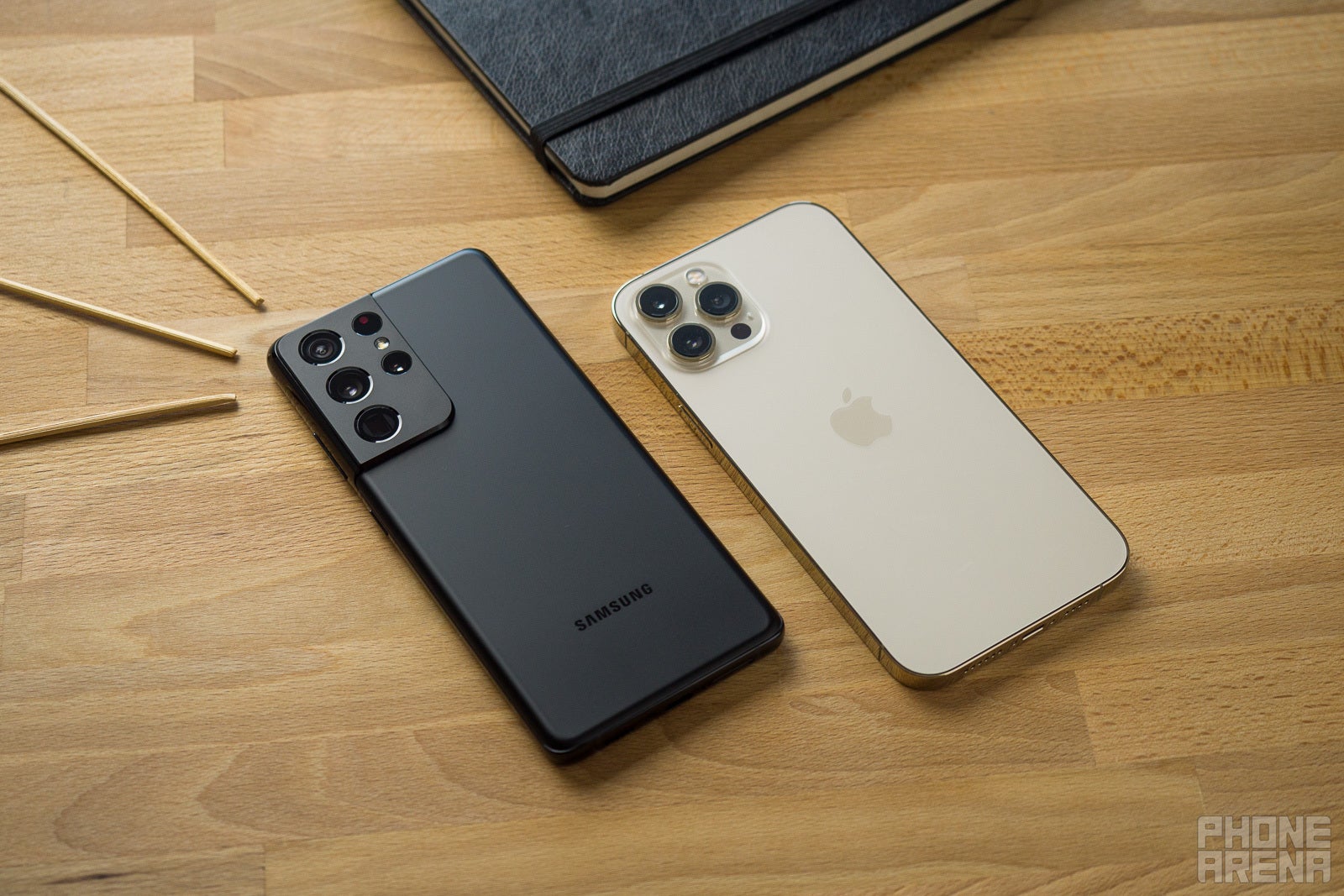
- 5,000mAh (Galaxy S21 Ultra) vs 3,687mAh (iPhone 12 Pro Max)
- Faster charging on Galaxy
Finally, these two also differ in their battery sizes. Android phones like the Galaxy S21 Ultra always come with bigger batteries than iPhones, and the S21 Ultra is no exception. It's projected to come with a 5,000mAh battery cell, compared to a 3,687mAh battery on the iPhone. That means the Galaxy has a nearly 50% larger battery capacity than the iPhone!
In real world use, we were getting north of 7 hours of screen time on the S21 Ultra, a bit more impressive than the iPhone, but to confirm that, we turn to our scientific battery tests!
Web Browsing Test (Wi-Fi, 200 nits brightness)
On our lightest test, web browsing, the S21 Ultra outlasted the iPhone even when it was running at the 120Hz Adaptive rate, which is a truly impressive achievement. We definitely recommend that smoother and more pleasing 120Hz mode, especially with such great battery life, but if you switch to 60Hz, you will indeed squeeze a bit more on this test. At 60Hz the S21 Ultra scored more than 16 hours, an all-time record for flagships!
YouTube Test
Our second test is streaming YouTube videos from the same playlist at the same, 1080p quality, and lo and behold, the S21 Ultra once again beats the iPhone with a small margin. Great showing for the Samsung and its battery so far.
3D Gaming Test
Last but not least, we have our gaming test, and if you play games like Call of Duty and Minecraft, this is the number one test that you should care about. While the other two tests load up the CPU, this one strains the GPU and shows how effective it is.
And once again, the Galaxy with outlasts the iPhone with a bit extra running time at 60Hz, but keep in mind that using 120Hz for gaming really hits the battery hard and you get nearly half the battery life you would get otherwise at just 5 hours of playtime at 120Hz. If you want a balance between performance and battery life, it really makes sense to game at 60Hz.
Charging
For charging, the iPhone 12 Pro Max supports speeds of up to 20W, while the Galaxy S21 Ultra supports marginally faster, 25W charging speeds. The iPhone was also the first mainstream phone on the market to ship without a charger, and the S21 Ultra is the first major Android phone to follow this unfortunate move.
Unfortunately, that means that these two premium flagship are behind the curve in charging times. It takes about an hour and a half to fully charge the S21 Ultra with a 25W charger, while using a 18W/20W charger on the iPhone takes up around 1 hour and 45 minutes. In times when phones charge at under an hour, and some can fully charge in half an hour, those speeds are just way too slow.
Both phones also support wireless charging at speeds of up to 15W with a compatible charger. The iPhone stands out here with its new MagSafe technology so the phone can magnetically and securely snap to chargers and accessories, a nifty little extra that you don't get on the Galaxy.
What the iPhone cannot do is reverse wireless charging, while the Samsung does have this option so you can place your Galaxy Buds Pro for example and quickly top them up using your Galaxy phone as a wireless power bank of sorts.
Prices

Last but not least, let's talk pricing. Market conditions this year have forced Samsung to lower its flagship phone prices. In 2020, Samsung launched its flagship S20 Ultra at an exorbitant price of $1,400, while this year's Galaxy S21 Ultra start at a more reasonable price starting at $1,200, which is still a bit more expensive than an iPhone 12 Pro Max.
Below, you will see the MSRP for both phones, but keep in mind that the Galaxy is commonly discounted and can be found for as low as $1,000 while price cuts for the iPhone are hard to come by, so chances are that you can get your Galaxy for a slightly lower price than an iPhone.
MSRPs:
- Samsung Galaxy S21 Ultra 5G — $1,200 for 128GB model, $1,250 for 256GB, $1,380 for 512GB
- Apple iPhone 12 Pro Max — $1,100 for 128GB model, $1,200 for 256GB, $1,400 for 512GB















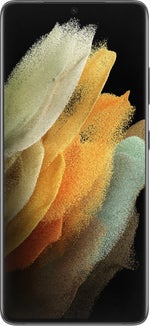
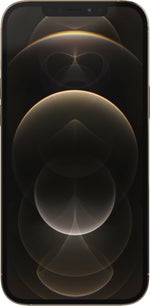























Things that are NOT allowed: